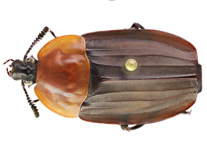Abstract
A taxonomic revision of the subgenus Calosilpha Portevin, 1920 (of the genus Necrophila Kirby & Spence, 1828) through Asia is presented. Four valid species are recognized: (1) Necrophila (C.) brunnicollis (Kraatz, 1877), widely distributed from Bhutan and China: Yunnan province to Far East of Russia and Japan (including Ryukyu Islands); (2) N. (C.) cyaneocephala (Portevin, 1914), endemic to Taiwan; (3) N. (C.) cyaniventris (Motschulsky, 1870), widely distributed from northern India to Vietnam and southern China (east to Hainan Island); and (4) N. (C.) ioptera (Kollar & Redtenbacher, 1844), comb. nov. (ex Calosilpha), widely distributed in Pakistan, India (Himachal Pradesh to Assam) and Nepal. Eusilpha (Calosilpha) bicolor imasakai Nishikawa, 1986 and Eusilpha (Calosilpha) kurosawai Nishikawa, 1986 are confirmed as junior subjective synonyms (sensu Cho & Lee 1995, Ji 2012) of Silpha brunnicollis Kraatz, 1877. Description of important adult taxonomic characters (including male genitalia) and a key to species is included. Georeferenced records for all four species are mapped. First reliable records of Necrophila (Calosilpha) brunnicollis from China: Hong Kong and Anhui, Fujian, Gansu, Hubei, Jiangxi, Jilin, Qinghai and Zheijiang provinces and Guangxi autonomous region; N. (C.) cyaniventris from India: Himachal Pradesh, Uttarakhand, Meghalaya, Arunachal Pradesh, Nagaland and Manipur; and N. (C.) ioptera from Pakistan, India: Uttarakhand, Uttar Pradesh, Bihar, Sikkim, West Bengal and Assam are given (only imprecise records from “Himalaya” had been published for the last two species). First records of N. (C.) brunnicollis from Bhutan, and of N. (C.) cyaniventris from China: Hainan and Yunnan provinces, Myanmar, Laos and Cambodia are given. Parsimony analysis supports the monophyly of Calosilpha, with two clades, one formed by N. (C.) brunnicollis and N. (C.) cyaneocephala and the other by N. (C.) cyaniventris and N. (C.) ioptera. Geometric morphometrics discriminated four taxa of Necrophila (Calosilpha). Results indicated a sexual dimorphism between sexes in all species. Shape variability was concluded between the taxa. Populations of N. (C.) brunnicollis from continental Asia and three regions of Japan (Honshu + Shikoku, Kyushu and Ryukyus) also were examined. MANOVA was significant and supported shape differences in male and female populations. When testing each pair of groups by discriminant analysis, only differences between male populations from Japan (Kyushu) and those from Japan (Honshu + Shikoku) showed insignificance.

